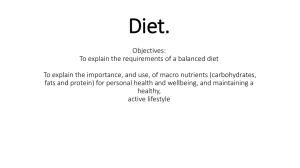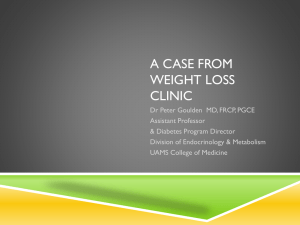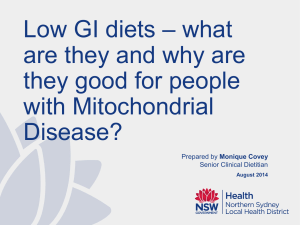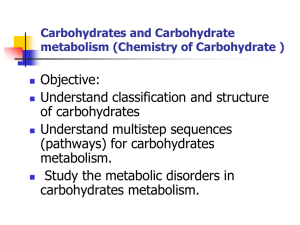Slide 1 - Abbott Nutrition
advertisement
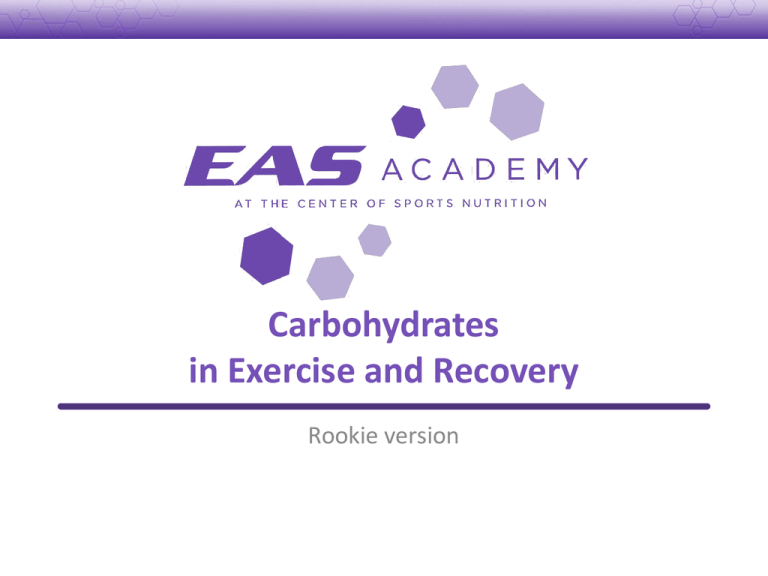
Carbohydrates in Exercise and Recovery Rookie version Outline I. Carbohydrates: Definitions, digestion, absorption A. Carbohydrates in the diet B. Digestion and absorption of carbohydrates C. Carbohydrate metabolism D. Glycogen—storage of carbohydrates in the body II. Properties of carbohydrates: Considerations for sports performance A. Glycemic index B. Glycemic load C. High-fructose corn syrup III. Training A. Carbohydrates before exercise B. Carbohydrates during exercise C. Recovery D. Meal planning IV. Competition A. Carbohydrate loading B. Pre-competition meals C. Carbohydrates during competition I. Carbohydrates: Definitions, Digestion, Absorption, and Storage Carbohydrates in Sports Nutrition Carbohydrates (CHOs) are a major fuel source for exercising muscle, especially in high-intensity or long-duration activities Carbohydrates can influence fluid absorption from the intestine (hydration) Some CHOs can cause gastrointestinal intolerance and thereby impair exercise performance Types of CHOs – Exogenous: CHO intake from the diet – Endogenous: CHO stored in the body (ie, glycogen) that can be used for energy needs Glycogen is stored glucose in the body – It is a network of glucose molecules connected together, similar to starch United States Anti-doping Agency. Optimal dietary intake guide. Available at: http://www.usada.org/diet/?gclid=COOM-Ky95aYCFQTNKgodzVQL2w. Accessed January 31, 2011. Carbohydrates in Diet Carbohydrates are found in the diet as 1. Free monosaccharides (1 sugar unit) • Glucose (aka dextrose, from corn and other plants) • Fructose (from fruit) • Galactose (from milk) 2. Di-, tri-, oligo- (4 to 10 units), or polysaccharides (chain of 11+ monosaccharides) • Sucrose (disaccharide of glucose + fructose) • Lactose (disaccharide of glucose + galactose) • Maltose (disaccharide of 2 glucose molecules) • Trehalose (disaccharide of 2 glucose molecules, with a different linkage between the two) • Starch (polysaccharide of glucose) Berg JM, et al. Biochemistry. 5th ed. New York, NY: WH Freeman and Co; 2002. Carbohydrate Digestion Carbohydrates are absorbed as monosaccharides Enzymes must digest di-, tri-, oligo-, and polysaccharides into individual monosaccharides – Enzymes exist in the saliva, stomach, and small intestine to break the different linkages between the various sugars There are special transporters in the cell membranes of intestinal cells that selectively absorb monosaccharides – Monosaccharides are then transported into the blood stream, where they are distributed throughout the body Carbohydrates that escape digestion and absorption make their way to the colon (with variable degrees of bacterial fermentation) Holmes R. J Clin Pathol. 1971;5(suppl):10-13. Why Is Carbohydrate Absorption Important in Sports Nutrition? The ability of the intestine to absorb a carbohydrate can be the rate-limiting step for its delivery to muscle cells for fuel use Enzyme systems in the intestine may be insufficient to digest some carbohydrates (eg, lactose intolerance) Intestinal sugar transporters can become saturated, resulting in malabsorption of a carbohydrate There are multiple transporters for carbohydrates – Ingest a blend of sugars that require different intestinal transporter systems (ie, glucose and fructose) • Avoids saturation of any one transporter – May increase carbohydrate absorption relative to using just a single sugar Carbohydrate Metabolism Glucose Fructose Glucose intermediate Galactose Glycogen Glycolysis CO2 Pyruvate oxidation Krebs cycle (aka tricarboxylic acid or TCA cycle) Electron transport chain Berg JM, et al. Biochemistry .5th ed. New York, NY: WH Freeman and Co.; 2002. ATP energy Storage of Carbohydrate in the Body If glucose is absorbed, but not needed right away, the body stores a small amount as glycogen – Glycogen is a fluctuating storage pool for glucose – The structure of glycogen is similar to starch – Found in the liver and skeletal muscles • Glycogen in liver is a reserve glucose supply to the brain • Glycogen in muscles is an energy source for exercise Berg JM, et al. Biochemistry .5th ed. New York, NY: WH Freeman and Co.; 2002. Glycogen During Exercise During exercise, glycogen is broken down and glucose molecules enter glycolysis (ie, energy metabolism) Vitamin B6 is a structural part of the enzyme that breaks down glycogen – Shows one of the many roles of B-vitamins in energy metabolism Glycogen can supply the body with only a limited amount of energy – Exogenous carbohydrates are important for high-intensity and long-duration exercise Eat carbohydrates immediately after exercise for most rapid glycogen replenishment (recovery) – Ingestion of 50 grams of carbohydrate every 2 hours can result in up to 5% glycogen replacement per hour • Therefore, total replacement would take 20 hours Hui YH. Handbook of Food Science, Technology, and Engineering. Volume 1. Boca Raton, FL: CRC Press; 2006:10-12. United States Anti-doping Agency. Optimal dietary intake guide. Available at: http://www.usada.org/diet/?gclid=COOM-Ky95aYCFQTNKgodzVQL2w. Accessed January 31, 2011. Tardie G. The Sports Journal. Available at: http://www.thesportjournal.org/article/glycogen-replenishment-after-exhaustive-exercise. Accessed February 17, 2011. II. Properties of Carbohydrates: Considerations for Sports Performance Glycemic Response to Carbohydrates in Sports Nutrition Ingestion of carbohydrates affects both blood glucose levels and insulin response (glycemic response)1 – Can influence energy sources during exercise One measure of glycemic response is the glycemic index (GI)2,3 Glycemic load is a relatively new measure for glycemic response4 – Based on the concept that exercise performance may be determined by both carbohydrate ingestion and the glycemic response of the overall diet 1. Mondazzi L and Arcelli E. J Am Coll Nutr. 2009;28:455S-463S. 2. Burke LM, et al. Int J Sport Nutr. 1998;8:401-415. 3. Donaldson CM, et al. Int J Sport Nutr Exerc Metab. 2010;20:154-165. 4. O’Reilly J, et al. Sports Med. 2010;40:27-39. 12 What Is the Glycemic Index? System of ranking foods according to how much they raise blood glucose relative to a reference food – Developed by Jenkins DJ, et al. Am J Clin Nutr. 1981;34(3):362-366. Rapidly digested or absorbed carbohydrates = high GI Slowly digested or absorbed carbohydrates = low GI References on GI – Brand-Miller J, et al. The New Glucose Revolution. 3rd ed. New York, NY: Marlowe & Co.; 2006 • Written by experts on GI – Atkinson, et al. Diabetes Care. 2008;31(12):2281-2283 • Most comprehensive table of the glycemic index of foods that has been assembled to date Abbreviations: GI, glycemic index. Figure from http://www.glycemicindex.com/aboutGI.htm. What Does the Glycemic Index Value Mean? The glycemic index (GI) is expressed as a ratio comparing the blood glucose increase caused by a test food to that of a reference food (usually glucose, historically white bread) for 2 hours following ingestion: Area Under the Curve for Test Food Area Under the Curve for Reference Food GI values: Split peas = 25 ± 6 Golden delicious apples = 39 ± 3 Oatmeal = 51 ± 8 Raisin bran flake type of cereal = 61 ± 5 White bread = 75 ± 2 Long-grain white rice = 76 ± 7 Corn flake type of cereal = 81 ± 3 Atkinson FS, et al. Diabetes Care. 2008;31(12):2281-2283. × 100 = GI Slow and Fully Digested CHOs (Low GI) Isomaltulose1 – Glucose and fructose – More steady and sustained release of glucose into the blood compared with sucrose – Occurs naturally in honey, but can be synthesized from sucrose Sucromalt2 + – Produced by enzymatic conversion of sucrose and maltose into a fructose and oligosaccharide syrup • ~40% fructose, ~50% oligosaccharides, and ~10% other mono- and disaccharides – Digestion profile similar to isomaltulose Gamma-cyclodextrin (γ-CD)3 – Ring of 8 glucose molecules Abbreviations: CHO, carbohydrate; GI, glycemic index. 1. Lina BA, et al. Food Chem Toxicol. 2002;40(10):1375-1381. 2. Xtend™ Sucromalt. Cargill, Inc. Available at: http://www.cargill.com/food/na/en/products/sweeteners/specialty-sweeteners/xtendsucromalt/index.jsp. Accessed February 24, 2011. 3. Munro IC, et al. Regul Toxicol Pharmacol. 2004;39:S3-13. What Is the Glycemic Load? Takes into account the amount of carbohydrate in a common serving in addition to its glycemic index GL = (GI of CHO × gram CHO per serving) ÷ 100 Example – Carrots (peeled, boiled) have a GI of 47 and 5 g CHO per serving The GL of carrots is: (47 × 5) ÷ 100 = 2.4 Abbreviations: CHO, carbohydrate; GL, glycemic load; GI, glycemic index. Atkinson FS, et al. Diabetes Care. 2008;31(12):2281-2283. Glycemic Index and Load Standards for Foods GI (based on glucose reference) – Low GI – Intermediate GI – High GI 0-55 56-69 ≥ 70 GL – Low GL – Intermediate GL – High GL 0-10 11-19 ≥ 20 Abbreviations: GI, glycemic index; GL, glycemic load. Brand-Miller J, et al. The New Glucose Revolution: The Authoritative Guide to the Glycemic Index-The Dietary Solution for Lifelong Health. 3rd ed. New York, NY: Marlowe and Co.; 2006. Brand-Miller JC, et al. Am J Clin Nutr. 2003;77(4):993-995. Limitations of glycemic index approach before and during exercise Clinical data have been mixed regarding the effectiveness of the glycemic index (GI) in food choice before exercise – Some discrepancies associated with how researchers evaluate exercise performance • Benefits observed in some time to exhaustion studies • Mainly no benefits in studies of time trial performance – No adverse effects of low glycemic index foods on performance have been observed Carbohydrate ingestion during exercise can help maintain blood glucose and eliminate the need for low glycemic index pre-exercise food – Low glycemic index pre-exercise foods, though, may help reduce insulin response (may positively affect fat utilization during exercise) – If an athlete has inadequate access to carbohydrate during an event, low glycemic index carbohydrates before event may be helpful Some of the low glycemic index foods used in research studies (e.g., lentils) might not be palatable as pre-exercise foods for athletes Burke LM, et al. Int J Sport Nutr. 1998;8:401-415. Donaldson CM, et al. Int J Sport Nutr Exerc Metab. 2010;20:154-165. 18 What Is High-Fructose Corn Syrup? Cornstarch is converted to corn syrup that is essentially 100% glucose Enzymes and processing techniques convert some of the glucose to fructose to achieve corn syrup that is 55% fructose (HFCS-55) HFCS-55 is the type of corn syrup used mainly in the beverage industry – Syrup is 55% fructose, 45% glucose – Similar to sucrose (table sugar; 50% fructose, 50% glucose) The term “high-fructose corn syrup” is a little misleading – Because corn syrup is 100% glucose, any presence of fructose typically results in it being labeled “high-fructose corn syrup” Soenen S, et al. Am J Clin Nutr. 2007;86(6):1586-1594. Smith JS, et al. Food Processing: Principles and Applications. Ames, IA: Blackwell Publishing; 2004:212-214. The Truth About High-Fructose Corn Syrup Too much sugar, of any kind, in beverages is not recommended – It is easy to consume too much energy, leading to weight gain – Most sugar-sweetened beverages provide little to no vitamins, minerals, or other essential nutrients However, there are no differences in metabolic responses to high-fructose corn syrup vs sucrose in humans – No differences in circulating hormones – No differences in appetite or satiety-related variables (fullness) DiMeglio DP, et al. Int J Obesity. 2000;24:794-800. Melanson KJ, et al. Nutrition. 2007;23(2):103-112. Stanhope KL, et al. Am J Clin Nutr. 2008;87(5):1194-1203. Soenen S, et al. Am J Clin Nutr. 2007;86(6):1586-1594. III. Training Carbohydrates and Sports Nutrition Important for maximizing muscle glycogen stores – Depleted muscle glycogen—“Hitting the wall” – Depleted liver glycogen—“Bonking” – Both phenomena are experienced as a precipitous loss of energy as a result of low blood sugar Training and high carbohydrate diets maximize glycogen stores United States Anti-doping Agency. Optimal dietary intake guide. Available at: http://www.usada.org/diet/?gclid=COOMKy95aYCFQTNKgodzVQL2w. Accessed January 31, 2011. Ensminger A. Foods and Nutrition Encyclopedia 2nd Edition Volume 1. Boca Raton, FL: CRC Press LLC; 1994. Pages 1202-1203. Burke L. Practical Sports Nutrition. Champaign, IL: Human Kinetics; 2007. Page 124. Clark N. Sports Nutrition Guidebook 4th Edition. Champaign, IL: Human Kinetics; 2008. Page 119. Carbohydrate and Fat Use at Different Exercise Intensities As the intensity of exercise increases, muscle glycogen constitutes a greater portion of the energy source (Weightlifting, sprinting, etc) Energy Expended, cal/kg/min 300 (Soccer, dancing, etc) Muscle glycogen 200 Muscle triglyceride 100 0 (Leisurely walking, slow cycling) 25 65 85 Maximal Oxygen Consumption, % Abbreviations FFA, free fatty acid. Romijn JA, et al. Am J Physiol. 1993;265(Part 1):E380-E391. Plasma FFA Plasma glucose Carbohydrates in the Days Before Exercise High glycogen stores are very important to prolong endurance – Related to diet and exercise in the days and hours before exercising/competing – Endogenous carbohydrate oxidation occurs at high intensity – Especially important for events longer than 90-120 minutes (eg, marathons and cycling events) United States Anti-doping Agency. Optimal dietary intake guide. Available at: http://www.usada.org/diet/?gclid=COOM-Ky95aYCFQTNKgodzVQL2w. Accessed January 31, 2011. Latta S. Marathon & Beyond. 2003;7(5). Carbohydrates 1 to 2 Hours Before Exercise Low glycemic index foods and beverages – Especially important for endurance exercise Carbohydrates that are also low in fiber may be beneficial due to varied gastrointestinal sensitivity among individuals – Examples • Fruit juices • Bagels • Breakfast cereals with < 3 g fiber/serving • Potatoes Carbohydrate amounts vary among individuals, sport type, and sport intensity United States Anti-doping Agency. Optimal dietary intake guide. Available at: http://www.usada.org/diet/?gclid=COOM-Ky95aYCFQTNKgodzVQL2w. Accessed January 31, 2011. Wu CL and Williams C. Int J Sport Nutr Exerc Metab. 2006;16(5):510-527. Carbohydrates During Exercise Are Also Important Jeukendrup (2004) reviewed multiple studies (n = 22) of walking, running, and cycling in which carbohydrates were given during exercise – 23 of 36 observations within these studies showed a positive effect of carbohydrate on endurance – Effective dose • Minimum, 16 to 22 g carbohydrate/hour • Maximum, 75 g carbohydrate/hour – No studies showed an adverse, or ergolytic, effect of carbohydrate on performance – Form of carbohydrate (solid or liquid) was of little significance, although the vast majority of the studies used a beverage Sports beverages that include different types of sugars will be absorbed via different sugar transporters in the gut – Increase exogenous carbohydrate oxidation during exercise from 1.0 g/min to 1.2 to 1.5 g/min Jeukendrup AE. Nutrition. 2004;20(7-8):669-677. Carbohydrates After Exercise Carbohydrates that are quickly digested and absorbed are recommended postexercise to restore muscle glycogen levels as fast as possible – Glucose – Maltose – Maltodextrin Protein + carbohydrates postexercise maximizes the rate of glycogen synthesis When intervals between exercise sessions are < 8 hours, consume carbohydrates as soon as practical postexercise for fastest recovery Ivy JL, et al. J Appl Physiol. 2002;93:1337-1344. Recommendations for Carbohydrate Intake During Recovery Carbohydrate intakes are expressed per kga not % of energy – For immediate recovery after exercise (0 to 4 hours) • 1.2 g/kg/hr consumed at frequent intervals For daily recovery, range of 3-12 g/kg/day; adjust with consideration of: – – – – aMultiply Athlete’s total energy needs Specific training needs and stage of training Feedback from training performance Training intensity • 3-5 g/kg/day: very light training programs (low-intensity or skill-based exercise) • 5-7 g/kg/day: moderate intensity training programs for 60 min/day • 6-10 g/kg/day: moderate- to high-intensity endurance exercise for 1-3 hours per day • 8-12 g/kg/day: moderate- to high-intensity exercise for 4-5 hours/day the numbers by 0.45 to get carbohydrate intake in grams per pound of body weight. Burke LM, et al. J Sport Sci. 2004;22(1):15-30. Putting Together a Meal Plan Example: – 70-kg athlete requiring 4000 kcal/day and exercising 120 min/day 4 to 6 times/week Macronutrient Target Recommendations – Grams/kg (body weight)/day • Carbohydrate • Protein • Fat 7 to 10 g/kg/day (490 to 700 g/day) 1.5 to 2.0 g/kg/day (105 to 140 g/day) Typically use percentage of energy as method – Percentage of energy • Fat 20% to 35% of energy (88 to 156 g/day) – Target recommendations for this athlete • Carbohydrate • Protein • Fat 600 g (60% of energy) 130 g (13% of energy) 120 g (27% of energy) A Potential Distribution of Macronutrients Over the Course of 6 Meals/Day Meal Time Carbohydrate, g Protein, g Fat, g Breakfast 7:00 AM 90 15 15 Mid-AM snack 10:00 AM 25 10 5 Noon 75 20 20 Pre-Ex meal 1:30 - 2:00 PM 90 10 5 During Ex 3:00 - 5:00 PM 100 0 0 Post-Ex meal 5:00 PM 75 30 25 Dinner 6:30 PM 120 30 35 PM snack 9:00 PM 25 15 15 600 130 120 Lunch TOTALS Foods Containing Approximately 25 to 30 g Carbohydrate 1 cup of juice or 1 large piece of fruit 1 bagel or 2 slices of bread 1 cup of most cereals 1 large baked potato 2 cups of milk ⅔ cup of dried beans 1 cup of rice or corn 1 cup of squash (other non-starchy vegetables have less carbohydrate) 2 cups of commercial sports/electrolyte replacement drink ½ to 1 energy bar (1 bar 25 to 45 g carbohydrate) 1 pack of energy gel ( 25 g carbohydrate) Atkinson FS, et al. Diabetes Care. 2009;31(12):2281-2283. Examples of Postexercise Meals Option 1 – – – – 1 regular bagel 2 Tablespoons peanut butter 8 fl oz skim milk 1 medium banana Meal provides 562 kcal, 77 g carbohydrate, 23 g protein, and 18 g fat Option 2 – 17-oz commercial nutrition shake Provides 300 to 420 kcal, 17 to 70 g carbohydrate, 32 to 42 g protein, and 2 to 16 g fat IV. Competitions Competition Competitions sometime require different carbohydrate intakes than practice – Endurance may be required for a longer amount of time – Maximum glycogen levels are optimal for best performance and require time to build (on the order of days; not possible for practices) Do not try any new foods in competition before you try it at least once at practice Carbohydrates as Energy at Different Times Carbohydrate consumed in the days before event – Used to provide adequate glycogen stores in muscle • Prevent “hitting the wall” Carbohydrate consumed in the hours before the event – Used to preserve liver glycogen stores, which can deplete after approximately 8 to 12 hours of fasting Carbohydrate consumed during event – Used to maintain blood glucose, especially when liver glycogen is depleted • Carbohydrate in the hours before and during exercise helps to prevent “bonking” United States Anti-doping Agency. Optimal dietary intake guide. Available at: http://www.usada.org/diet/?gclid=COOMKy95aYCFQTNKgodzVQL2w. Accessed January 31, 2011. Ensminger A. Foods and Nutrition Encyclopedia 2nd Edition Volume 1. Boca Raton, FL: CRC Press LLC; 1994. Pages 1202-1203. Burke L. Practical Sports Nutrition. Champaign, IL: Human Kinetics; 2007. Page 124. Clark N. Sports Nutrition Guidebook 4th Edition. Champaign, IL: Human Kinetics; 2008. Page 119. Carbohydrate Loading Traditional protocol – Depletion of glycogen stores (~ days 6 to 3 before event) • Low-carbohydrate diet and hard exercise – Supercompensation of muscle glycogen (during the 36 to 48 h prior to event) • Very high-carbohydrate diet (10 to 12 g/kg body weight/day) and tapering of exercise Cons – Depletion phase is hard on the body and difficult to tolerate in training • May lead to headaches, irritability, and increased risk of injury Pre-Competition Meal One of the most variable aspects of the athlete’s diet – Depends on individual tolerance – Athletes often have certain beliefs about food’s effect on performance – Ranges from no food to the old “steak and eggs” breakfast – Depends on the sport to some degree Functions of the pre-event meal – – – – Prevent dehydration Maintain adequate muscle and liver glycogen levels Avoid excess hunger feelings Confidence in preparation for the event Pre-Competition Meal (continued) Medium amount of energy – 300 to 500 kilocalories, more if there is time to digest before the event 2 to 3 hours before event (perhaps 1 hour with liquid meal) – Ingestion of carbohydrate 1 hour before exercise does not usually impair performance – Depends on individual tolerance Liquid meals are popular for gastrointestinal comfort during the event GI of pre-event carbohydrates – No solid evidence for this, experiment in practice Include 1 to 2 cups of fluid Avoid foods with a high fat content and/or excess fiber Abbreviations: GI, glycemic index. Examples of Pre-Competition Meals Option 1, liquid meal (blend all ingredients)1 – – – – 1 cup of vanilla yogurt 4 to 6 peach halves, canned or fresh 4 graham cracker squares Dash nutmeg, optional Meal provides 450 kcal, 75% CHO, 15% protein, and 10% fat Option 2 Food Kcal Carbohydrate, g Protein, g Fat, g Oatmeal, instant 1 pkt 104 18 4 2 Skim milk, ½ cup 43 6 4 0 Toast, 2 slices 146 24 4 2 Banana, 1 medium 105 27 0 1 Orange juice, 6 oz 84 20 1 0 TOTAL 482 95 (80%) 13 (11%) 5 (9%) Abbreviations: CHO, carbohydrate; pkt, packet. 1. Clark N. Sports Nutrition Guidebook. Champaign, IL: Human Kinetics; 1989. Carbohydrates During Competition Consuming carbohydrate is neither practical nor necessary during exercise lasting less than 45 minutes Small amounts of carbohydrate from sports drinks or foods may enhance performance during sustained high-intensity exercise lasting 45-75 minutes Athletes should consume 30-60 g carbohydrate per hour from carbohydrate-rich fluids or foods during endurance and intermittent, high-intensity exercise lasting 1-2.5 hours During endurance and ultra-endurance exercise lasting 2.5-3 hours and beyond, athetes should consume upt to 80-90 g carbohydrate per hour – Products providing multiple transportable carbohydrates are necessary to achieve these high rates of carbohydrate oxidation Jeukendrup AE. Nutrition. 2004;20(7-8):669-677. Burke LM, et al. Carbohydrates for training and competition. J Sport Sci. 2011 (in press as of April 2011). Summary of Key Messages A diet with high carbohydrate availability helps to maximize glycogen stores and generally increases exercise performance Consuming carbohydrate during exercise also generally helps performance – Experiment in practice regarding tolerated levels – Liquid carbohydrates also help with hydration Eating as soon as possible after exercise promotes the most rapid recovery of muscle glycogen – Combination of carbohydrate and protein may facilitate this process Frequent, smaller meals can help athletes with high energy and carbohydrate requirements get in the required amounts of nutrients

